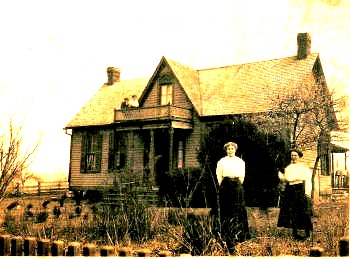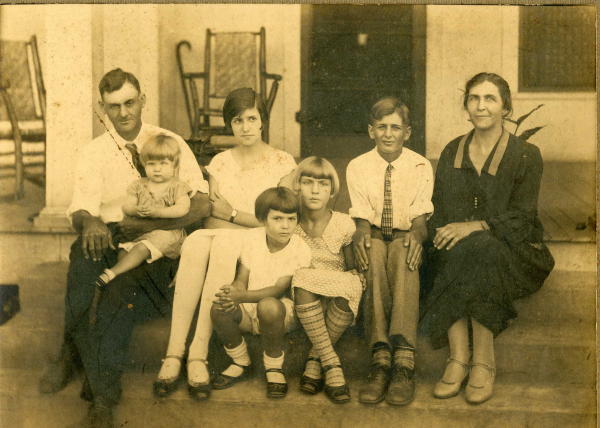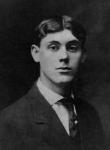|

The
McCash/McCamy/Erwin/Rymer House c. 1909,
Built 1878. I. S. McCash was a "Carpet
Bagger" from "up-north" who bought this
farm after the civil war and built a
barn in 1877 and the house in 1878. This
photo taken in 1909 shows Frances (l)
and Roberta (R) standing in the yard. It
is believed the youth on the upper porch
was Julian Erwin.
|
Married
Life
Frances and Albert were married in her parents
home on May 31th, 1912. For more information on
the old house, barn and farm Old house infoThis property
is still in the family and is where Harry and
Kathy Rymer live (2010).
At the time they were married Albert
was as a carpenter working on a construction crew
building the Flume Line. As there were hundreds of
construction personnel, and little information on
individual living conditions, we do not know where
he lived. Albert probably did not live at home due
to the difficulty of commuting to work from his
family home.
Frances was living in the home shown
above. She had taught school at a schoolhouse on
Horns Creek road just east of the intersection of
Swan road, less than a half mile from home.
On March 17th, 1913 Frances and
Albert had their first child, Frank Albert.(For
information on any persons in the Rymer family,
click on "Rymer History" in the top tab and then
click on "Lineage" in the left panel) At the time
they were living at the mouth of Goforth creek
where it empties into the Ocoee river. There were
two very small cabins taking up all of the level
ground in the area.
The Flume Line was finished a few
months after Frank was born, the construction
workers were laid off and Albert's career as a
carpenter was over. After being laid off Albert
and Frances moved to a house about a mile south of
her family home on Swan road. We have no data on
this but until there is some proof, we will
believe they were renting. Sue was born there in
October, 1914. For the rest of his life Albert was
a farmer.
About the same time the Rymer family
moved to Polk county (1830's), the McCamy family
moved to Murray county Georgia. (These counties
share a common border) Both families moved in as
soon as, or maybe a little before, the indians
were removed. One of the McCamys settled on over
600 acres in an area known locally as "Fairy
Valley". This farm had remained in the family and
at the time was owned by Howard McCamy, Frances's
brother. Howard needed someone to run the farm as
he was a businessman in Kentucky and Albert needed
a larger farm to support his growing family. As
later told, at Howard's urging, Frances and Albert
moved to Murray county. Howard was to furnish
financing when needed and Albert was to manage the
farm. Details of this arrangement are not known.
The farm had at least the following houses on it
at this time:
1. A nice house on the main road from Knoxville to
Atlanta, now US 411
2. A house a few hundred yards west of the main
house
3. A house on the east side of the farm, across
the creek and up next to Sand Mountain. This was a
poor tenant house.
Probably during the early 1920's,
but maybe a few years before, Frances's brother
John took possession of an acre or so of the farm
on the main road at the northern border. John, who
never married, build a very nice home for his
parents and himself on this property. This house
was 200 - 300 yards north of the main farm house.
Sometime between 1914 and 1919, a
deal was struck with Howard on Albert managing the
farm, Frances, Albert and family moved to the farm
in Murray County Georgia. On March 4th, 1919
Elizabeth was born in the house west of the main
house.
Shortly after Elizabeth was born the
family moved into the main house on what is now US
Highway 411. Onie was born in the main house on
June 9th 1921 The family kept getting larger
The early 1920's were a good time
for farmers and for The United States, we had just
won the "War to end all Wars", technology was
increasing at a rapid pace, production was booming
and the prices farmers received for farm products
such as; cotton and grain were high. Albert was a
man who studied farming and used good farming
practices, he ran a large productive farm and took
care of both the farm and equipment. As a modern
farmer, Albert had one of the first tractors and
associated equipment in the area. It was a large
tractor with steel wheels and about 6 miles per
hour top speed. Albert and his family were a
relatively well to do farm family. In looking back
it is easy to see a decline in the price of farm
products, starting in 1927 was the first
indication of the great depression which was to
follow. However, no one can foresee the future and
everyone expected the good times to continue.
In the 1920's a Delco plant was
installed in a small building just back of the
house. Delco was a company who developed a
gasoline engine coupled to a generator that
charged a number of batteries. The furnished power
to a home or business. Each battery was in a
rectangle shaped glass jar large enough to hold
about 2 gallons of liquid. As each battery
provided 2 volts, a small unit contained 16
batteries. The batteries and engine required
frequent maintenance as the liquid level in the
batteries was critical to the operation. These
were very popular in rural areas for those who
could afford them. Delco was bought out by General
Motors; Delco batteries are still produced for
cars and trucks.
On June 12th, 1926 Mary was born in
the same house as Onie. Albert and Frances now
have 5 children and only the oldest one was a boy.
Frank now 13, was a hard worker and able to do a
lot of work in the fields. The older girls also
helped in the fields hoeing and other of the less
strenuous tasks.
|

The Rymer Family 1928
Albert, Mary, Sue, Onie, Elizabeth, Frank,
Frances
on the front steps of their home in
Georgia
Before John and Bob were born
|
From the beginning of farming until
the 1930's farmers had two goals; the first was to
raise food for themselves and to feed the cows,
horses and other farm animals, the second was to
raise something they could sell for money, "cash
crops" as they were known. Usually a farmer had
two or more "cash crops" such as potato's, wheat,
cotton and corn. One of Albert's "cash crops" was
to grow sweet potato "slips" to sell to neighbors.
This entailed building a long rectangle about 4
feet wide, by laying logs on the ground and
filling the rectangle with sawdust. Sweet potatoes
were then buried in the sawdust, which was kept
wet. The rectangle or "bed" was covered with a
very thin cloth which allowed the sunlight in, but
prevented frost from killing the tender plants. In
a few days, young plants, called slips, grew from
the potato's begin to grow through the sawdust,
when they were about 6 - 8 inches high the slips
were picked and bundled into bunches of 25, 50, or
100. Other farmers would come by and buy the
number of slips they wanted. Onie and Elizabeth
can remember picking and bundling the slips.
In 1928, Frances was again with
child, what if it was another girl? While farm
prices continued to drop, 1928 was a good year, it
was a boy, John born on May 21st and Albert bought
a new "A" model Ford car.
In the 1920's, we are not sure of
the year, Albert who loved to hunt had a very good
hunting dog and was offered $500.00 for it, about
the same as the price of a new "A" model Ford. He
turned it down, three months later the dog got
distemper and died.
1931 was a terrible year. The
depression was heavy upon the land and hit farmers
especially hard. The year began cold and wet,
Albert was out in the cold and rain trying to sell
farm products when he became sick. Albert became
sicker and was taken to the hospital in Knoxville,
Frances who heavy with child, stayed on the farm.
On January 31st she gave birth to Bob. The next
day Albert died with spinal meningitis. His body
was brought back from Knoxville and he was buried
at Summerhour cemetery. If this was not enough for
Frances, left with 7 children from one day to 17
years old, more trouble became manifest later that
same year.
Howard had borrowed money to buy the
farm, from his sister Roberta and her husband Ben
Rucker. He could not make the payments, the
Ruckers foreclosed. Ben Rucker, who had been
superintendent of schools in Knoxville, decided he
wished to retire from his job, move to the farm
and become a farmer. Frances and her family was
given until December of 1933 to move. After Albert
and Frances were married, Frances's mother and
father sold the farm where they were married to
Lena (the oldest daughter) and her husband, Bob
Erwin. In 1932 Bob was in his 60's and wanted to
semi-retire from farming. Frances, with the help
of a government program to provide low cost loans
for farmers to buy land and equipment started in
1916, bought the house she was married in together
with approximately 50 acres of the farm for
$2,000.00. The loan may have been for more than
$2,000.00 because Frank bought a pair of young
mules, Matt and Mandy, and a plow along with other
equipment needed. Farmers at that time normally
moved at the year end, the last crops were in and
when it was time to start preparing for new crops.
On the first on January, 1934 Frank moved to the
house where Harry and Kathy Rymer now live (2010).
Prior to the depression the Shed
Presbyterian church had a full time pastor, a
manse for the pastor was built on the corner of
Horns Creek road from about an acre of the old
farm. As the depression grew, roads and
transportation became easier, people began to go
further to church, the membership and attendance
at the Shed declined until it could no longer
support a pastor. As a result, the church became a
"yoked" church meaning one pastor served 3 or 4
churches visiting and preaching on say the 3rd
Sunday of each month. The manse was no longer used
and The Erwins bought it and moved into it when
Frank moved into the house we bought.
But we digress, to schools in
Georgia. From the home in Georgia the nearest
school was called "Halls Chapel" a one room church
half a mile or so through the woods southwest of
where we lived and used as a school during the
week. Halls Chapel was a grammar school, grades 1
- 8 and had two teachers who each taught 4 grades.
For those who wanted to go further the school was
in Eton, a few miles south. There was one catch,
transportation was not furnished. Frances and
Albert saw to schooling Frank, Sue, Elizabeth and
Onie by having them board with a family in Eton
during the week.
Frances, who had a teaching degree
from Young-Harris college, obtained a job teaching
at Halls Chapel for the 1933-34 year. John, who
was barely 5, attended as a first grade student.
We remember the pay as $15.00 per month. Frances,
together with Mary and John walked across the
woods every day to Halls Chapel, Elizabeth and
Onie stayed and went to school in Eton. Frank and
Sue had finished high school. When school was out
the rest of the family moved to Tennessee where
Frank had been busy getting ready to plant the new
crops.
During the years the Erwins had
lived in the old house not much maintenance was
done. The house at one time had been painted white
had only specks of paint smaller than the size of
a pencil eraser left to tell it had once been
painted. Inside maintenance had also been
neglected. Parts of the roof were the original
wooden shingles, over 50 years old. In the winter
when it snowed, if you slept in one of the
upstairs bedrooms, you sometimes would wake up
with snow flakes on the covers.
The farm was a "dry" farm meaning no
running streams on it to furnish water for the
stock. The house was located on top of a hill and,
according to the story, a well had been dug but no
water was found. At any rate, both the family and
the animals water came from cisterns. One cistern
collecting water from the north side of the barn
and and two cisterns, one on each side of the
eastern part of the house furnishing water for the
family. If I remember correctly, at the time we
moved the gutters were wooden boards nailed in a
"V" shape.
When
we lived in Georgia the family attended the
Summerhour Methodist Church, where Frances's
mother and father along with other family members
were buried. In Polk County there was not a
Methodist Church in the area so we attended The
Shed Presbyterian church. It was an old church,
established in the 1839, the same year Polk County
was formed. After World War II the number of
attendees declined until the church was closed.
For more info about The Shed Click Here.
Times were hard in Tennessee, the
farm was run down, cotton was 10 cents a pound,
after it was ginned. Our corn crop was about 300
bushels which was just enough to feed the animals
and provide corn meal for cornbread for the
family. Frank, who was 20 when we moved, worked
from daylight to after dark to provide for his
mother and six siblings. He also kept up with the
latest farming practices and applied them to the
farm. He built terraces to help hold in the water
where it fell, planted legumes for providing hay
and building up the soil. One of the legumes was
imported from Korea by the dept of Agriculture and
touted about all of its properties. Problem was it
made lousy hay and animals would only eat it to
keep from starving. Today you see it along road
banks to prevent erosion.
As the economy improved Frank worked
both the farm and other jobs. He worked at Dixie
Foundry (later Magic Chef) in Cleveland for 13
cents per hour and went out on strike for higher
wages. When US 64 highway was paved he got a job
inspecting the quality of the concrete. He also
got a job building a transmission line to the
powerhouse above Reliance, he recalled carrying up
to 20 foot long lengths of steel to build
transmission towers from the road to the top of
each mountain or hill in the middle of summer.
More to be added 12/4/09
Back
|



